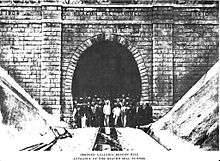Beacon Hill Tunnel (Hong Kong)
|
South portal of the new Beacon Hill tunnel, as viewed from Kowloon Tong Station | |
| Overview | |
|---|---|
| Line | East Rail Line |
| Coordinates | 22°20′22″N 114°10′27″E / 22.3395°N 114.1743°ECoordinates: 22°20′22″N 114°10′27″E / 22.3395°N 114.1743°E |
| Status | Active |
| System | MTR |
| Start | Kowloon Tong |
| End | Tai Wai |
| Operation | |
| Work begun | 1978 |
| Constructed | 1978 |
| Opened | 1981 |
| Traffic | Train |
| Technical | |
| Length | 2.3 km |
| No. of tracks | Double |
| Track gauge | 1,435 mm (4 ft 8 1⁄2 in) |
| Electrified | 25 kV 50 Hz AC |
| Tunnel clearance | 9.0 m |
| Width | 11.1 m |
Beacon Hill Tunnel is a railway tunnel in Hong Kong on the original Kowloon-Canton Railway, linking Kowloon Tong to its immediate south and Sha Tin to its north. The nearest stations to the south and north of the tunnel are Kowloon Tong and Tai Wai respectively. Today, the tunnel carries the MTR East Rail Line metro service and through trains to Mainland China.
There are actually two tunnels of this name. The first (Chinese: 煙墩山隧道) opened in 1910 and operated until its replacement (Chinese: 筆架山隧道) came into operation following its 1981 completion.
History
 Old Beacon Hill Tunnel in 1910, south portal | |
| Overview | |
|---|---|
| Status | Disused for train, now occupied by town gas pipeline |
| System | Kowloon–Canton Railway |
| Start | Kowloon Tong |
| End | Tai Wai |
| Operation | |
| Opened | 1 October 1910 |
| Technical | |
| Length | 2.2 km |
| No. of tracks | Single |
| Track gauge | 1,435 mm (4 ft 8 1⁄2 in) |
| Tunnel clearance | 5.8 m above rail level |
| Width | 5.2 m |
A team of surveyors was commissioned to plan the route for the KCR British Section in 1905. Two routes were proposed:
- Construction of a tunnel 1.5 mile (2.4 km) long through Beacon Hill, then following the west coast of Tolo Harbour
- Routing through western New Territories and Castle Peak Bay
Although option two was less of an engineering challenge, the overall route was longer, and passed through less economically active areas; therefore option one was selected. Works on the 35.4 kilometres (22.0 mi) railway to the border started early 1906. Construction of the tunnel, referred to as Tunnel No.2 in the plan (since it was the second tunnel out from the Kowloon terminus), was the greatest engineering project in Asia of its time.[1]
Construction of the tunnel presented great engineering challenges during construction of the line, and local workers were very reluctant to work underground due to feng shui-related objections.[1] The tunnel cost £298,500 to build and opened with rest of the line on 1 October 1910, together with four smaller tunnels along the line.[2] It accommodated a single standard track with a standard gauge of 1,435 mm (4 ft 8 1⁄2 in). Throughout its operating life, the tunnel was noted for its fume problems, due to its relatively steep gradient of 1%.
As part of the modernisation of the KCR, under reformist Governor Murray MacLehose, a double-tracked, electrified tunnel was built 30 to 40 metres west of the original one.[3] Work started in 1978, and was completed by 1981, enabling the KCRC to introduce a metro-standard service to serve the rapidly growing new towns north of the mountain range. The original tunnel was closed upon completion of the new one, and is now partially occupied by a 750 mm diameter town gas pipeline.[4]
Dimensions
| Wikimedia Commons has media related to Beacon Hill Tunnel. |
First tunnel
- single track
- 2.2 km long
- horseshoe-shaped, 5.2 metres wide by 5.8 metres high above rail level.
- up to 427 metres below ground
- tunnel lining upgraded in 1982 and 2008[4]
Second tunnel
- double track
- 2.3 km long
- horseshoe-shaped, 11 metres wide by 9 metres high[4]
References
- 1 2 One Hundred Years of Railway Operations in Hong Kong (PDF). Hong Kong: Kowloon-Canton Railway Corporation & MTR Corporation Limited. 2010. pp. 11–12. Retrieved 2015-05-07.
- ↑ "KCR an important link between HK and China". South China Morning Post. Hong Kong. 10 September 1975. p. 38.
- ↑ A Century of Railway Development – The Hong Kong Story, Charles C P Lung, Institution of Railway Signal Engineers
- 1 2 3 "Catalogue of Hong Kong Tunnels (Up to 2015)" (PDF). Geotechnical Engineering Office, Civil Engineering and Development Department. March 16, 2009. Retrieved 2015-05-07.
Bibliography
- Phillips, Robert J. (1990). Kowloon-Canton railway (British section): A History. Urban Council.